
Radio-controlled helicopter
Encyclopedia
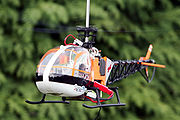
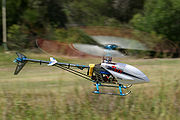
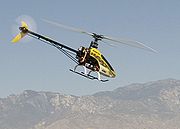
Radio-controlled helicopters (also RC
Radio control
Radio control is the use of radio signals to remotely control a device. The term is used frequently to refer to the control of model vehicles from a hand-held radio transmitter...
helicopters) are model aircraft
Model aircraft
Model aircraft are flying or non-flying models of existing or imaginary aircraft using a variety of materials including plastic, diecast metal, polystyrene, balsa wood, foam and fibreglass...
which are distinct from RC airplanes because of the differences in construction, aerodynamics
Aerodynamics
Aerodynamics is a branch of dynamics concerned with studying the motion of air, particularly when it interacts with a moving object. Aerodynamics is a subfield of fluid dynamics and gas dynamics, with much theory shared between them. Aerodynamics is often used synonymously with gas dynamics, with...
, and flight training. Several basic designs of RC helicopters exist, of which some (such as those with collective pitch, meaning blades which rotate on their longitudinal axis to vary or reverse lift) are more maneuverable than others. The more maneuverable designs are often harder to fly, but benefit from greater aerobatic
Aerobatics
Aerobatics is the practice of flying maneuvers involving aircraft attitudes that are not used in normal flight. Aerobatics are performed in airplanes and gliders for training, recreation, entertainment and sport...
capabilities.
Flight controls allow pilots to control the collective and throttle (usually linked together), the cyclic controls (pitch and roll), and the tail rotor (yaw). Controlling these in unison enables the helicopter to perform most of the same maneuvres as full-sized helicopters, such as hovering and backwards flight, and many that full-sized helicopters cannot.
The various helicopter controls are effected by means of small servo motors, commonly known as servos. A piezoelectric gyroscope
Vibrating structure gyroscope
A vibrating structure gyroscope is a type ofgyroscope that functions much like the halteresof an insect.The underlying physical principle is that a vibratingobject tends to continue vibrating in the same planeas its support rotates...
is typically used on the tail rotor (yaw) control to counter wind- and torque-reaction-induced tail movement. This "gyro" does not itself apply a mechanical force, but electronically adjusts the control signal to the tail rotor servo.
The engines typically used to be methanol-powered two-stroke motors, but electric brushless motors combined with a high-performance lithium polymer battery or lipo are now more common and provide improved efficiency, performance and lifespan compared to brushed motors, while decreasing prices bring them within reach of hobbyists. Gasoline and jet turbine engines are also used.
Types of R/C helicopters
Common power sources are nitro (nitromethane-methanolMethanol
Methanol, also known as methyl alcohol, wood alcohol, wood naphtha or wood spirits, is a chemical with the formula CH3OH . It is the simplest alcohol, and is a light, volatile, colorless, flammable liquid with a distinctive odor very similar to, but slightly sweeter than, ethanol...
internal combustion), electric batteries, gas turbines, petrol and gasoline.
Mechanical layouts include cyclic/collective pitch mixing
Cyclic/collective pitch mixing
Used in radio-controlled helicopters, Cyclic/collective pitch mixing reduces mechanical complexity and increases precision of control of the helicopter rotor's swashplate.- Conventional operation :...
(CCPM) in all power sources, fixed-pitch electric rotors and coaxial electric rotors
Coaxial rotor
Coaxial rotors are a pair of helicopter rotors mounted one above the other on concentric shafts, with the same axis of rotation, but that turn in opposite directions...
.
Practical electric helicopters are a recent development but have rapidly developed and become more common, overtaking nitro helicopters in common use. Gas-turbine helicopters are also increasing in popularity, although the high cost puts them out of reach of most people.
Nitro (glow fuel)
Nitro or glow fuelGlow fuel
Glow fuel is a generic term used to describe a fuel source used in model engines -- generally the same or similar fuels can be used in model airplanes, helicopters, cars and boats. Glow fuel can be burned by very simple two stroke engines or by more complicated four stroke engines and these...
helicopters come in different sizes: 15, 30, 50, 60 and 90 size. These numbers originated from the size of engine used in the different models (0.30 cu in, 0.50 cu in and so on). The bigger and more powerful the engine, the larger the main rotor blade that it can turn and hence the bigger the aircraft overall. Typical flight times for nitro helicopters is 7–14 minutes depending on the engine size and tuning. The maximum height of operation for RC helicopters, be it nitro or electric, is only limited to the height at which the controller can see the model. Most radio systems have a range of over a mile, and the person controlling the model will have long lost sight of the model.
Electric
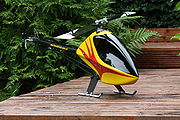
Recent advancements in battery technology are making electric flying more feasible in terms of flying time. Lithium polymer (LiPo) batteries are able to provide the high current required for high performance aerobatics while still remaining very light. Typical flight times are 4–12 minutes depending on the flying style and battery capacity.
In the past electric helicopters were used mainly indoors due to the small size and lack of fumes. Larger electric helicopters suitable for outdoor flight and advanced aerobatics have become a reality over the last few years and have become very popular. Their quietness has made them very popular for flying sites close to residential areas and in places such as Germany
Germany
Germany , officially the Federal Republic of Germany , is a federal parliamentary republic in Europe. The country consists of 16 states while the capital and largest city is Berlin. Germany covers an area of 357,021 km2 and has a largely temperate seasonal climate...
where there are strict noise restrictions. Nitro helicopters have also been converted to electric power by commercial and home made kits.
The smallest remote-controlled production model helicopter made (Guinness World Records 2006) is the Picooz Extreme MX-1 sold at many toy stores (although this is infrared controlled, not radio), electronics stores and internet stores, costing about $30 (£28). The next smallest is the standard Picooz
Picoo Z
The Picoo Z is a miniature remote-controlled 2-channel helicopter manufactured by Hong Kong-based Silverlit Toys...
helicopter.
Several models are in contention for the title of the smallest non-production remote-controlled helicopter, including the Pixelito family of micro helicopters, the Proxflyer
Proxflyer
Proxflyer refers to a family of micro R/C helicopter prototypes based on a dual coaxial counter-rotating rotor concept developed and patented by Norwegian Petter Muren. The concept differs from the swashplate designs in conventional helicopter flight controls and enables a helicopter to be...
family, and the Micro flying robot
Micro flying robot
The Micro Flying Robot is the world’s smallest and lightest robot helicopter prototype, which was developed by Seiko Epson and demonstrated at the International Robot Exhibition in Tokyo in Nov 2003...
.
A recent innovation is that of coaxial electric helicopters. The system's inherent stability has, in recent years, made it a good candidate for the design of small models for beginner and/or indoor use. Models of this type, as in the case of a full-scale helicopter, eliminate rotational torque and extremely quick control response, both of which are very pronounced in a CCPM
Cyclic/collective pitch mixing
Used in radio-controlled helicopters, Cyclic/collective pitch mixing reduces mechanical complexity and increases precision of control of the helicopter rotor's swashplate.- Conventional operation :...
model.
While a coaxial model is very stable and can be flown indoors even in tight quarters, such a helicopter has limited forward speed, especially outdoors. Most models are fixed-pitch, i.e. the collective pitch of the blades cannot be controlled, plus the cyclic control is only applied to the lower rotor. Compensating for even the slightest breeze causes the model to climb rather than to fly forward even with full application of cyclic. More advanced coaxial constructions with two swash plates and/or pitch control - common for the big coaxial helicopters like Kamov
Kamov
Kamov is a Russian rotor-winged aircraft manufacturing company that was founded by Nikolai Il'yich Kamov, who started building his first rotor-winged aircraft in 1929, together with N. K. Skrzhinskii...
s - have been realized as models in individual projects but have not seen the mass market as of 2009.
Radio
Small fixed-pitch helicopters need a 4-channel radio (throttleThrottle
A throttle is the mechanism by which the flow of a fluid is managed by constriction or obstruction. An engine's power can be increased or decreased by the restriction of inlet gases , but usually decreased. The term throttle has come to refer, informally and incorrectly, to any mechanism by which...
, elevator
Elevator (aircraft)
Elevators are flight control surfaces, usually at the rear of an aircraft, which control the aircraft's orientation by changing the pitch of the aircraft, and so also the angle of attack of the wing. In simplified terms, they make the aircraft nose-up or nose-down...
, aileron
Aileron
Ailerons are hinged flight control surfaces attached to the trailing edge of the wing of a fixed-wing aircraft. The ailerons are used to control the aircraft in roll, which results in a change in heading due to the tilting of the lift vector...
, rudder
Rudder
A rudder is a device used to steer a ship, boat, submarine, hovercraft, aircraft or other conveyance that moves through a medium . On an aircraft the rudder is used primarily to counter adverse yaw and p-factor and is not the primary control used to turn the airplane...
), although micro helicopters that utilize a 2-channel infrared control system also exist; while collective-pitch models need a minimum of 5 channels with 6 being most common (throttle
Throttle
A throttle is the mechanism by which the flow of a fluid is managed by constriction or obstruction. An engine's power can be increased or decreased by the restriction of inlet gases , but usually decreased. The term throttle has come to refer, informally and incorrectly, to any mechanism by which...
, collective pitch, elevator
Elevator (aircraft)
Elevators are flight control surfaces, usually at the rear of an aircraft, which control the aircraft's orientation by changing the pitch of the aircraft, and so also the angle of attack of the wing. In simplified terms, they make the aircraft nose-up or nose-down...
, aileron
Aileron
Ailerons are hinged flight control surfaces attached to the trailing edge of the wing of a fixed-wing aircraft. The ailerons are used to control the aircraft in roll, which results in a change in heading due to the tilting of the lift vector...
, rudder
Rudder
A rudder is a device used to steer a ship, boat, submarine, hovercraft, aircraft or other conveyance that moves through a medium . On an aircraft the rudder is used primarily to counter adverse yaw and p-factor and is not the primary control used to turn the airplane...
and gyro gain). Because of the normal interaction of the various control mechanisms, advanced radios include adjustable mixing functions, such as throttle/collective and throttle/rudder.
Radio prices vary from $100–$2,000 USD.
Some vary from $50–$100 USD.
Well-known manufacturers of helicopter-specific radio controllers include: JR
Japan Remote Control
Japan Remote Control Co., Ltd. is a Japanese manufacturer of popular radio control devices including transmitters, receivers, servos, electronics, programmable robots and model aircraft.-Overview:Unique to JR Propo's radios is the company's patented ABC&W technology, or...
, Spektrum
Spektrum RC
Spektrum is brand of radio control systems designed for use with hobby radio-controlled cars and aircraft. Spektrum is a division of Horizon Hobby....
, Futaba
Futaba RC
is a Japanese company that is most known for designing and manufacturing hobby-grade radio control systems including transmitters, receivers, servos, electronics and model aircraft...
, Hitec
Hitec
Hitec is a company based in South Korea that manufactures radio control devices, including transmitters, receivers, servos, electronics and model aircraft. Later products include robotics, servos with Karbonite gears and the Robonova--a humanoid robot accepted in the Robo one robot competition....
, Sanwa
Sanwa Denshi
is a general electronics manufacturer, but is best known internationally as a leading manufacturer of arcade parts; i.e. joysticks, buttons, coin feeds etc. Its parts are commonly used in Japanese arcade machines and held in high regard by custom builders ....
(known as "Airtronics" in North America), Multiplex
Multiplex Modelsport
Multiplex Modellsport GmbH & Co. KG of Bretten-Gölshausen, Germany is a manufacturer of hobby-grade radio control electronics, electric radio-controlled airplanes and electric helicopters....
(a division of Hitec). The original preferred user interface for helicopter-oriented RC transmitters at the beginning of the RC helicopter hobby, from the early 1970s through about 1990, was the so-called "single-stick" or "knobby" style of multi-channel RC transmitter, possessing a single primary two-axis joystick with a special rotatable, self-centering knob atop the single joystick's shaft for all three of the helicopter's aerodynamic controls, combined into only one primary control mechanism. The horizontal/vertical joystick movements of such a joystick provide cyclic contol, and the knob is used for operating the tail rotor control. Such radios became unavailable as factory-built new units at the start of the 1990s, but newer units are still made by RC-flying electronics hobbyists well into the 21st century in North America for their own personal use, for flying both RC helicopters and fixed-wing RC model aircraft.
Modulation
Radios emit the FM signal in two types of modulationModulation
In electronics and telecommunications, modulation is the process of varying one or more properties of a high-frequency periodic waveform, called the carrier signal, with a modulating signal which typically contains information to be transmitted...
.
PPM is cheaper than PCM and is generally used in low-end helicopters. The lack of a failsafe in PPM makes it more suited to small, less dangerous models. Higher-end radios offer PCM and PPM modulation for better compatibility with all radio receivers.
PCM
Pulse Code Modulation. A scheme in which the commanded position for each servo is transmitted as a digitally encoded number. Manufacturers use their own proprietary system to encode this number with various levels of precision (i.e. variable number of bits per servo position). JR use Z-PCM (9 bits, 512 different values: 0...511) then S-PCM (10 bits, 1024 values: 0...1023). Futaba use PCM-1024 and G3 PCM (11 bits, 2048 values: 0...2047). With PCM not all positions are broadcasted at one time (each frame) to save time. The odd numbered positions are sent as absolute in one frame, with the even sent only as differences from their previous values. The next frame the opposite is done. PCM includes a checksumChecksum
A checksum or hash sum is a fixed-size datum computed from an arbitrary block of digital data for the purpose of detecting accidental errors that may have been introduced during its transmission or storage. The integrity of the data can be checked at any later time by recomputing the checksum and...
at the end of the frame to check the signal's validity. Hence, if there is interference and the signal arrives distorted at the Receiver, utilizing the checksum it is able to know if it is the original. In case it is not, a feature called Fail-Safe is implemented to set servo positions to a predefined position, or to hold them at the last valid position.
PPM
Pulse-position modulationPulse-position modulation
Pulse-position modulation is a form of signal modulation in which M message bits are encoded by transmitting a single pulse in one of 2^M possible time-shifts. This is repeated every T seconds, such that the transmitted bit rate is M/T bits per second...
. A scheme in which the commanded position for each servo is transmitted as the duty-cycle
Duty cycle
In engineering, the duty cycle of a machine or system is the time that it spends in an active state as a fraction of the total time under consideration....
of the transmitted pulses 1 per servo position.
Spread spectrum
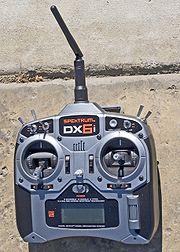
Frequency-hopping spread spectrum
Frequency-hopping spread spectrum is a method of transmitting radio signals by rapidly switching a carrier among many frequency channels, using a pseudorandom sequence known to both transmitter and receiver...
) used by Futaba employ frequency hopping on the 2.4 GHz band instead of the various frequencies in the lower MHz ranges. The advantage is that radios are no longer using a fixed frequency during flight but a multitude of frequencies.
Systems such as Spektrum and JR use the DSM2 DSSS(Direct-sequence spread spectrum
Direct-sequence spread spectrum
In telecommunications, direct-sequence spread spectrum is a modulation technique. As with other spread spectrum technologies, the transmitted signal takes up more bandwidth than the information signal that is being modulated. The name 'spread spectrum' comes from the fact that the carrier signals...
) method, where they transmit on a pair of fixed channels chosen when the radio and receiver are turned on. Any subsequent systems would avoid using these channels and continue searching for another unused pair of channels.
With either method many radios can be transmitting at once without interfering with each other. The Futaba systems change frequency approximately every two milliseconds, so even if two transmitters are using the same channel they are not doing so for long. The pilot will not notice any abnormal behavior of the model in the 1/500th of a second that they are interfering. This gives one the advantage of turning on a transmitter without regard to channels currently in use by other pilots' radios.
One downside to 2.4 GHz is that precautions must be taken during installation since certain materials such as carbon fiber can mask the signal. In some cases, "satellite" receivers with secondary antennas need to be used to maintain better line-of-sight with the transmitter radio. Another drawback is that a 2.4 GHz standard has yet to evolve so that receivers and transmitters can be mixed regardless of their respective manufacturer.
Controls
RC Helicopters usually have at least four controls: Roll - Cyclic Pitch, Elevator (Fore-Aft Cyclic Pitch), Rudder (Yaw) and Pitch/Throttle (Collective Pitch/Power).For simple flight, the radio is usually configured such that pitch is around -1 degree at 0% throttle stick, and somewhere around 10 degrees at 100% throttle stick. It is also necessary to modulate the throttle in conjunction with the pitch so that the model maintains a constant 'head speed' (the rotor's RPM). This is beneficial for consistent and smooth flight performance.
If aerobatic '3D' performance is desired, then the 'idle up' mode of flight is used. In this mode, the collective pitch ranges from its negative limit at 0% throttle stick input, up to its positive limit at 100% throttle stick. The throttle, on the other hand, is modulated automatically by the radio transmitter to maintain a constant head speed and is usually at its lowest value when the throttle stick is centered and the pitch is zero. This mode allows the rotor to produce a thrust 'upwards' (by using negative pitch) which, when the model is inverted, allows sustained inverted flight. Usually a more advanced computer radio is used for this kind of flying, which allows customization of the throttle-collective mix.
The cyclic and yaw controls are not by definition different in these two modes, though 3D pilots may configure their models to be much more responsive.
Construction
Construction is typically of plastic, glass-reinforced plastic, aluminium or carbon fiber. Rotor blades are typically made of wood, fiberglass or carbon fiber. Models are typically purchased in kit form from one of about a dozen popular manufacturers and take 5 to 20 hours to completely assemble.These model helicopters contain many moving parts analogous to those on full-size helicopters, from the swashplate
Swashplate (helicopter)
A swashplate is a device that translates input via the helicopter flight controls into motion of the main rotor blades. Because the main rotor blades are spinning, the swashplate is used to transmit three of the pilot's commands from the non-rotating fuselage to the rotating rotor hub and...
to rotor
Helicopter rotor
A helicopter main rotor or rotor system is a type of fan that is used to generate both the aerodynamic lift force that supports the weight of the helicopter, and thrust which counteracts aerodynamic drag in forward flight...
and everything in between.
The construction of helicopters has to be more precise than for fixed-wing model aircraft, because helicopters are susceptible to even the smallest of vibrations, which can cause problems when the helicopter is in flight.
Additionally, the small size and low weight of R/C helicopters and their components means that control inputs, especially cyclic (pitch and roll) can have a very fast response, and cause a rotation rate much faster than the equivalent input might produce on a full-size aircraft. In some cases, this quick response can make the model unnecessarily difficult to fly. For this reason, most model helicopters do not use the (simpler) Bell rotor head design, but instead use the Hiller design with a flybar, or Bell-Hiller mixing, the former providing a much greater degree of stability, and the latter mixing the quick response of the Bell system with the stability of the Hiller design. Some models use the simple Bell design, but this is limited mainly to scale models that are more challenging to fly, or models using advanced electronic stabilizing equipment.
To reduce mechanical complexity and increase precision of the control of the swashplate
Swashplate
A swashplate is a device used in mechanical engineering to translate the motion of a rotating shaft into reciprocating motion, or to translate a reciprocating motion into a rotating one to replace the crankshaft in engine designs.- Construction :...
some model helicopters use Cyclic/collective pitch mixing
Cyclic/collective pitch mixing
Used in radio-controlled helicopters, Cyclic/collective pitch mixing reduces mechanical complexity and increases precision of control of the helicopter rotor's swashplate.- Conventional operation :...
.
Competition
Aerobatic helicopter flying has historically followed the Fédération Aéronautique InternationaleFédération Aéronautique Internationale
The Fédération Aéronautique Internationale is the world governing body for air sports and aeronautics and astronautics world records. Its head office is in Lausanne, Switzerland. This includes man-carrying aerospace vehicles from balloons to spacecraft, and unmanned aerial vehicles...
rules,
which for helicopters are labelled F3C. These include a predetermined routine of hovering and aerobatics.
An advanced form of RC helicopter flying is called 3D. During 3D flying, helicopters perform advanced aerobatics
Aerobatics
Aerobatics is the practice of flying maneuvers involving aircraft attitudes that are not used in normal flight. Aerobatics are performed in airplanes and gliders for training, recreation, entertainment and sport...
, sometimes in a freestyle form, or in a predetermined set of moves drawn up by the organisers of the competition. There are a number of 3D competitions around the world, two of the best known being the 3D Masters
3D Masters
3D Masters is an international 3D radio-controlled helicopter competition held over three days in July. The competition is held over three days during July. The 3D Masters is a premier radio controlled helicopter, attracting several elite model pilots from around the world.The event attracts...
in the UK
United Kingdom
The United Kingdom of Great Britain and Northern IrelandIn the United Kingdom and Dependencies, other languages have been officially recognised as legitimate autochthonous languages under the European Charter for Regional or Minority Languages...
and the eXtreme Flight Championship (XFC) in the USA.
Commercial applications
Although RC helicopters are generally used by hobbyists for recreational purposes, they are sometimes used in applications such as low altitude aerial photographyAerial photography
Aerial photography is the taking of photographs of the ground from an elevated position. The term usually refers to images in which the camera is not supported by a ground-based structure. Cameras may be hand held or mounted, and photographs may be taken by a photographer, triggered remotely or...
, filming, policing, and remote observation or inspection. Some companies make RC helicopters specifically for these uses.
Recent (2006) FAA regulations grounding all commercial RC model flights have been upgraded to require formal FAA certification before permission to fly at any altitude in USA. Refer to http://www.dvinfo.net/forum/digital-video-industry-news/145993-rc-aerials-illegal-says-faa.html
Remotely piloted or autonomous helicopters powered by electric motor
Electric motor
An electric motor converts electrical energy into mechanical energy.Most electric motors operate through the interaction of magnetic fields and current-carrying conductors to generate force...
s instead of by gasoline
Gasoline
Gasoline , or petrol , is a toxic, translucent, petroleum-derived liquid that is primarily used as a fuel in internal combustion engines. It consists mostly of organic compounds obtained by the fractional distillation of petroleum, enhanced with a variety of additives. Some gasolines also contain...
or diesel
Diesel engine
A diesel engine is an internal combustion engine that uses the heat of compression to initiate ignition to burn the fuel, which is injected into the combustion chamber...
internal combustion engine
Internal combustion engine
The internal combustion engine is an engine in which the combustion of a fuel occurs with an oxidizer in a combustion chamber. In an internal combustion engine, the expansion of the high-temperature and high -pressure gases produced by combustion apply direct force to some component of the engine...
, with electricity
Electricity
Electricity is a general term encompassing a variety of phenomena resulting from the presence and flow of electric charge. These include many easily recognizable phenomena, such as lightning, static electricity, and the flow of electrical current in an electrical wire...
provided by fuel cell
Fuel cell
A fuel cell is a device that converts the chemical energy from a fuel into electricity through a chemical reaction with oxygen or another oxidizing agent. Hydrogen is the most common fuel, but hydrocarbons such as natural gas and alcohols like methanol are sometimes used...
s or batteries
Battery (electricity)
An electrical battery is one or more electrochemical cells that convert stored chemical energy into electrical energy. Since the invention of the first battery in 1800 by Alessandro Volta and especially since the technically improved Daniell cell in 1836, batteries have become a common power...
include a type of small unmanned aerial vehicle
Unmanned aerial vehicle
An unmanned aerial vehicle , also known as a unmanned aircraft system , remotely piloted aircraft or unmanned aircraft, is a machine which functions either by the remote control of a navigator or pilot or autonomously, that is, as a self-directing entity...
(UAV) http://rotomotion.com/prd_UAV_SR20.html which can carry 10 pounds (4.5 kg) weight of payload.
See also
- A social network for RC enthusiasts
- Miniature helicopterMiniature helicopterMiniature helicopters are remotely controlled helicopters with a weight ranging from hundred grams to a few grams. Most in production are toys aimed at hobbyists and enthusiasts. In addition there are many companies making prototypes for military and security applications...

